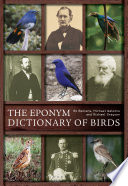Taphrospilus
Well-known member
Cichlherminia Bonaparte, 1854 OD t.38 (1854) - Comptes rendus hebdomadaires des séances de l'Académie des sciences - Biodiversity Heritage Library
Turdus lherminieri Lafresnaye, 1844OD 1844 - Revue zoologique - Biodiversity Heritage Library

 birdsoftheworld.org
birdsoftheworld.org
Here what we can find in Wikipedia Ferdinand Joseph L'Herminier — Wikipédia
About his birth Bach Viewer - FRAD971_1E5_052_105_001_C.jpg p. 10/15 I would say he was born 5 Floréal XI. Isn't it the 25. April 1803? Not sure if we can find the full record.
I did not check yet his death (according Wikipedia 12 December 1866 in Pointe-à-Pitre)
I would also go as well at Cichlherminia with Ferdinand Joseph l'Herminier and not with his father. Dito may Herminierus Lesson, 1843 1843 - Revue zoologique - Biodiversity Heritage Library for him?
It might be worth to check as well syn. Cinclocerthia tremula, syn. Onychoprion fuscatus, syn. Parkesia noveboracensis, ?syn. Platyrinchus platyrhynchos) mentioned in BOW Key
Melanerpes herminieri (Lesson, RP 1830) OD t.1 (1831) - Traité d'ornithologie, ou, Tableau méthodique des ordres, sous-ordres, familles, tribus, genres, sous-genres et races d'oiseaux - Biodiversity Heritage Library
Puffinus lherminieri Lesson, RP 1839 1839 - Revue zoologique - Biodiversity Heritage Library
Feel free to correct me and/or add any additional of value to this thread.
Deux autre espèces américaines de Turdi veri de mon Conspectus: T. herminieri Lafr. et densirostris, Vieill., forment mon genre Cichlherminia.
Turdus lherminieri Lafresnaye, 1844OD 1844 - Revue zoologique - Biodiversity Heritage Library
Quoique nous eussions déjà ces trois espèces, que nous devions à l'obligeance de M. L'Herminier, avant l'affreuse catastrophe de la Pointe-à-Pitre, nous ne les avions pas publiées parce qu'il nous avait confié son projet de publier une Faune ornithologique de la Guadeloupe.
The Eponym Dictionary of Birds
A comprehensive dictionary listing all the people whose names are commemorated in the English and scientific names of birds.Birdwatchers often come across bird names that include a person's name, either in the vernacular (English) name or latinised in the scientific nomenclature. Such names are...
books.google.de
Forest Trush genus Cichlherminia Bonaparte, 1854
4 Forest Thrush Cichlherminia lherminieri Lafresnaye, 1844 [Syn. Turdus lherminieri]
Dr Ferdinand Joseph L'Herminier (1802–1866) was a French osteologist, botanist, zoologist and ornithologist, and Director of the hospital on Guadeloupe. His father was Félix Louis L'Herminier (q.v.) All their notes and specimens were destroyed in an earthquake (1843). The genus name is made up of his surname combined with the Greek word for thrush: kikhle.
The Key to Scientific Names - Birds of the World
Species accounts for all the birds of the world.
CichlherminiaDr Ferdinand Joseph l'Herminier (1802-1866) French osteologist, ornithologist on Guadeloupe (Turdus)
(Turdidae; syn. Turdus Ϯ Forest Thrush T. lherminieri) Gr. κιχλη kikhlē thrush; Félix Louis l'Herminier (1779-1833) French military chemist, naturalist on Guadeloupe (cf. specific name Turdus lherminieri de La Fresnaye, 1844); "Deux autres espèces américaines de Turdi veri de mon Conspectus: T. herminieri, Lafr., et densirostris, Vieill., forment mon genre Cichlherminia." (Bonaparte 1854); "Cichlherminia Bonaparte, 1854, Compt. Rend. Acad. Sci. Paris, 38, p. 2. Type, by subsequent designation (Gray, 1855, Cat. Gen. Subgen. Birds, p. 43), Turdus lherminieri Lafresnaye." (Ripley in Peters, 1964, X, p. 162).
Var. Cinchlerminia.
Here what we can find in Wikipedia Ferdinand Joseph L'Herminier — Wikipédia
About his birth Bach Viewer - FRAD971_1E5_052_105_001_C.jpg p. 10/15 I would say he was born 5 Floréal XI. Isn't it the 25. April 1803? Not sure if we can find the full record.
I did not check yet his death (according Wikipedia 12 December 1866 in Pointe-à-Pitre)
I would also go as well at Cichlherminia with Ferdinand Joseph l'Herminier and not with his father. Dito may Herminierus Lesson, 1843 1843 - Revue zoologique - Biodiversity Heritage Library for him?
It might be worth to check as well syn. Cinclocerthia tremula, syn. Onychoprion fuscatus, syn. Parkesia noveboracensis, ?syn. Platyrinchus platyrhynchos) mentioned in BOW Key
Melanerpes herminieri (Lesson, RP 1830) OD t.1 (1831) - Traité d'ornithologie, ou, Tableau méthodique des ordres, sous-ordres, familles, tribus, genres, sous-genres et races d'oiseaux - Biodiversity Heritage Library
Puffinus lherminieri Lesson, RP 1839 1839 - Revue zoologique - Biodiversity Heritage Library
Feel free to correct me and/or add any additional of value to this thread.
Last edited:






